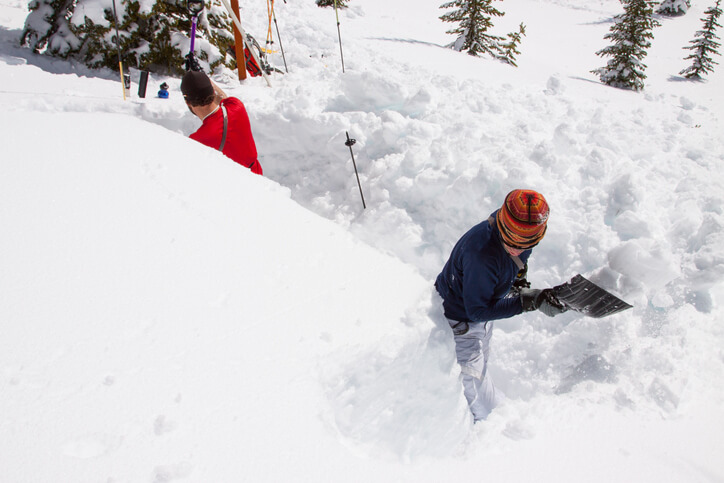Quick, name a piece of equipment that’s essential for winter camping!
If you answered “Winter clothing”, “4-season tents”, or a “snowshoes”, you’re not wrong, but for some reason, snow shovels rarely come to mind for a lot of people when it comes to winter camping.
In fact, snow shovels are must-have tools for practical and safety reasons. You’ll have plenty of reasons to dig through snow: carving space for your tent, building an igloo, or digging an outhouse. The shovel is also useful for collecting snow for water or clearing the surface of a frozen lake when fishing. Even if you’re not in the backcountry, a snow shovel can be used to dig your vehicle out of the snow. The sole alternative to snow shovels would be your hands, which is not a sensible option.

SAFETY USES
Aside from its practical applications, a snow shovel is crucial in rescue and emergency situations.
Shovels are useful tools to study snowpack conditions and determine if an avalanche is likely.
Should an avalanche occur, when time is critical to a successful rescue, the snow shovel is literally a life-saver: enabling you to dig someone out much faster and easier. In fact, proficiency in using a shovel is necessary when learning how to rescue someone buried in an avalanche.
A shovel is also handy when you need to make an emergency shelter. Such shelters need to be propped quickly to lessen the adverse effects from being exposed to the elements for too long.

WHAT TO LOOK FOR IN A BACKCOUNTRY SNOW SHOVEL
The last thing you would want to happen in a worst-case scenario is your equipment breaking down when you need it most. Therefore, you need to make sure your snow shovel is built to meet or exceed standards for safety equipment. Shovels with plastic blades are lighter and easier to carry, but a shovel with an aluminum handle and blade is more dependable.
The size and shape also play a role when looking for a good snow shovel. A long handle will make moving snow easier, but it will also be heavier and bulkier. Fortunately, telescopic handles on snow shovels are common now, and provide the best compromise between utility, compactness, and weight.

Handles mainly come in two types: D or T grips. T-grips are lighter, but D-grips have a more tactile gripping surface, making them easier to use with gloves and mittens, but weigh more as a consequence. When it comes to handles, this choice will depend more on personal preference.
Blades also come in different sizes and shapes. Bigger blades can move more snow in one motion, but take up more space and may weigh more than smaller tools. Smaller blades are easier to carry, but at the expense of shoveling efficiency. The shape of the blade also affects how you shape snow, with flat blades making cleaner snow-pit walls, but you really can’t go wrong with either a flat or serrated edge.
Many people opt to carry their military-style folding shovel in the winter, too. Striking a balance between logistics, durability and functionality ultimately comes down to individual needs and preferences, but the bottom line is having this indispensable tool with you when you’re traveling in the snow.


